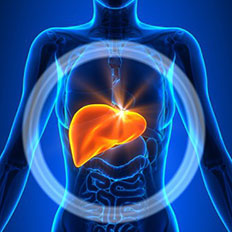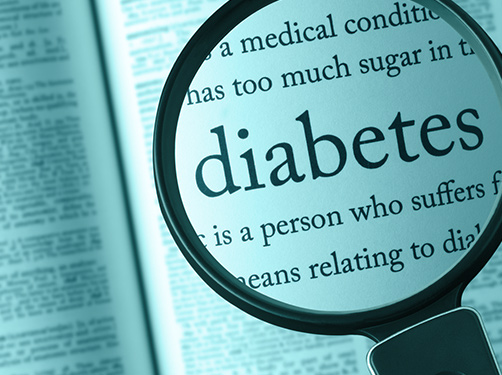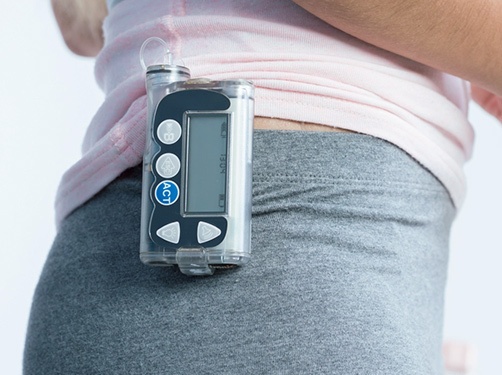Diabetes and Fatty Liver
Scientific support: Dr. Sofiya Gancheva
The liver is the primary organ of the human metabolism. The liver enables the body to absorb nutrients and removes toxic substances from the blood.
Metabolic disorders such as obesity (adiposity) and type 2 diabetes can harm the liver and lead to a condition known as fatty liver disease, simply referred to as “fatty liver.” By making consistent lifestyle adjustments, you can prevent the accumulation of fat in liver cells or even reverse it if the fatty liver disease is not advanced.

Contents
- What is fatty liver?
- How are fatty liver and type 2 diabetes connected?
- What are the signs of fatty liver?
- How can fatty liver disease be prevented?
- What increases the risk of fatty liver disease?
- How is fatty liver diagnosed?
- What health risks are associated with fatty liver?
- How is fatty liver treated?
- How prevalent is non-alcoholic fatty liver?
1. What is fatty liver?
Fatty liver disease is when fat begins to deposit in the liver cells – known as the hepatocytes. Fatty liver disease can be categorized into two types: alcohol-induced fatty liver disease and non-alcoholic fatty liver disease (NAFLD). NAFLD is diagnosed when more than 5 percent of liver cells have an excessive amount of fat. Fatty liver disease has become one of the most common medical reasons for liver transplants and is closely related to diabetes, particularly type 2 diabetes.
What’s unique about the relationship between fatty liver and type 2 diabetes is that both conditions influence each other. They can be both a cause and a consequence. This means that individuals with a fatty liver have a higher risk of developing type 2 diabetes, and type 2 diabetes, in turn, promotes the development or progression of fatty liver.
As the term “non-alcoholic fatty liver disease” can be stigmatizing and discriminatory, an internationally recognized expert committee has proposed renaming the condition. In the future, it should be referred to as “metabolic dysfunction-associated steatotic liver disease” (MASLD).
2. How are fatty liver and type 2 diabetes connected?
Very often, both type 2 diabetes and non-alcoholic fatty liver are associated with a condition called the metabolic syndrome, which involves the simultaneous presence of several diseases or symptoms. These include:
- Abdominal obesity or adiposity
- Elevated fasting blood sugar levels or existing type 2 diabetes
- Elevated triglyceride levels and low HDL cholesterol levels
- Hypertension
A significant cause of both metabolic syndrome and type 2 diabetes is insulin resistance.
Insulin resistance plays a central role
Recent research suggests that individuals with type 2 diabetes and insulin resistance are particularly vulnerable to developing a fatty liver. In people with insulin resistance, cells in muscles, the liver, and adipose tissue become less responsive to released insulin, resulting in less sugar (glucose) being absorbed from the blood into the body’s cells. This leads to elevated blood sugar levels.
In the case of adipose tissue, insulin resistance is especially noticeable in abdominal fat. Abdominal fat is highly metabolically active and releases numerous free fatty acids into the body, especially when insulin can no longer work effectively due to insulin resistance. These free fatty acids are then converted into triglycerides in the body and stored in liver cells, causing them to become “fatty.” Excessive fat accumulation in liver cells can lead to mild, chronic inflammation that can permanently damage liver tissue.
The uptake of triglycerides into liver cells is facilitated by insulin resistance, and conversely, the accumulation of fat in the liver cells intensifies insulin resistance, creating a sort of “vicious circle.”
3. What are the signs of fatty liver?
People with fatty liver or fatty liver inflammation typically don’t experience pain or other symptoms.
Nevertheless, the following symptoms can be signs of fatty liver disease:
- Continuous fatigue and listlessness
- Difficulty concentrating
- A feeling of pressure in the upper abdomen
- A frequent feeling of fullness
- Complaints when lying on the right side
- Dark urine
- Light stool
Good to know:
Fatty liver may be present even if liver values are normal.
4. How can fatty liver disease be prevented?
People with diabetes can take steps to prevent non-alcoholic fatty liver. A healthy lifestyle in particular plays a crucial role:
- Pay attention to your body weight and try to avoid being overweight, especially abdominal obesity. You should also adjust your calorie intake to your daily energy needs.
- Try to have an active lifestyle and incorporate regular physical activity and exercise into your daily routine.
- Try to avoid alcoholic drinks as much as possible and make sure to have a balanced and fiber-rich diet. Highly energy-rich foods with unhealthy fats and sugars, such as soft drinks, sweet snacks, and fatty sausages, are particularly unfavorable.
- Refrain from smoking.
A healthy lifestyle not only prevents fatty liver but also has a positive impact on inflammation processes, insulin resistance, blood sugar, and blood lipid levels.
Since non-alcoholic fatty liver and type 2 diabetes can mutually influence each other, it is essential to have your respective risk of developing these conditions examined early on. People with type 2 diabetes should be examined by their treating physician to determine if they have fatty degeneration of the liver or even fatty liver inflammation. This can prevent the onset of advanced liver damage.
Good to know:
Numerous studies indicate that fructose, especially a high intake of industrially produced fructose, promotes the storage of fat in liver cells. As a result, the risk of non-alcoholic fatty liver is significantly increased with high fructose consumption. Fructose also contributes to increased abdominal fat and insulin resistance.
Therefore, it’s worthwhile to check the ingredients of packaged foods: Industrially-produced fructose is increasingly used as a cost-effective raw material in the food industry, such as concentrated fructose corn syrup (also known as high fructose corn syrup, HFCS), which can be found in soft drinks, sweets, and processed foods.
5. What increases the risk of fatty liver disease?
Fatty liver can be triggered or promoted by various factors, including:
- Excessive alcohol consumption
- Lack of physical activity
- Poor diet
- Medication
- Pregnancy
- Old age
- Metabolic Syndrome (e.g., abdominal obesity, insulin resistance)
- Type 2 diabetes
- As an accompanying disease to other diseases (e.g., hepatitis C infection)
Non-alcoholic fatty liver is closely linked to being overweight (especially abdominal obesity), insulin resistance, and type 2 diabetes. Around 70 out of 100 people with type 2 diabetes have fatty liver disease.
Good to know:
Even individuals with normal weight can develop non-alcoholic fatty liver. This occurs less frequently and is often attributed to inherited causes.
In cases of non-alcoholic fatty liver in normal-weight individuals, the risk of developing type 2 diabetes doubles.
6. How is fatty liver diagnosed?
When there is suspicion of fatty liver, according to the German Society for Gastroenterology, Digestive and Metabolic Diseases (DGVS), the general health status should be assessed initially by measuring the Body Mass Index (BMI), waist circumference, and blood pressure. In addition, a blood test should be conducted, which includes specific liver values (transaminases), fasting blood sugar level, long-term blood sugar value (HbA1c), as well as blood lipids (triglycerides, HDL and LDL cholesterol).
This helps to determine whether type 2 diabetes or metabolic syndrome risk factors are present, which in turn increase the risk of fatty liver.
However, it’s important to note that a blood test alone is insufficient for diagnosing fatty liver, as liver values in the blood are often inconspicuous with fatty liver. Elevated blood values may also be attributable to other causes.
Through inquiry, excessive alcohol consumption, as well as other conditions such as lipid metabolism disorders or intestinal diseases, can be ruled out as possible causes of fatty liver.
To diagnose fatty liver, several non-invasive imaging methods can be used: Generally, the treating physician will conduct an ultrasound (sonography) examination. In cases of fatty liver disease, the organ appears lighter and larger than normal in the ultrasound images. Magnetic resonance spectroscopy (MRS) or elastography can also be used to diagnose fatty liver disease. MRS determines the fat content of the liver and elastography measures liver elasticity.
To exclude other liver diseases and to determine whether fatty liver or fatty liver inflammation is already present, a liver biopsy is necessary. A biopsy is an invasive procedure. A biopsy uses a needle to collect a sample of liver tissue to enable closer examination of the liver cells. A liver biopsy is often referred to as a liver puncture.
7. What health risks are associated with fatty liver?
Non-alcoholic fatty liver can have serious health consequences, especially when fat deposits have already led to persistent inflammation in the liver. Untreated, this can lead to fibrosis (accumulation of fibrous tissue) and cirrhosis (scarring of the liver). In this stage, the liver can only perform its various and vital functions to a limited extent. Possible late effects include:
- Ascites (fluid buildup in the abdomen)
- Brain dysfunction due to toxins that are no longer metabolized in the liver
- Liver cancer
Additionally, non-alcoholic fatty liver promotes insulin resistance, elevated blood sugar levels, and lipid metabolism disorders. All of these factors increase the risk of cardiovascular diseases. Furthermore, the risk of chronic kidney disease and diabetic polyneuropathy is elevated in individuals with fatty liver.
8. How is fatty liver treated?
Currently, there is no approved medication for non-alcoholic fatty liver disease. However, several medications are under research. Additionally, several blood sugar-lowering medications, such as SGLT-2 inhibitors and GLP-1 receptor agonists, are currently being tested specifically for the treatment of liver diseases.
The primary focus of treatment is lifestyle change, which has proven to be very effective for fatty liver.
If overweight, it is essential to reduce weight. Weight loss of only 5 or 10 percent can positively affect non-alcoholic fatty liver disease. Weight loss of 10 percent can even reverse non-alcoholic fatty liver disease. According to studies, a balanced diet and regular physical activity have very positive effects on the progression of non-alcoholic fatty liver disease. In addition to dietary changes, both endurance and strength training can be effective (3 hours per week at moderate intensity).
Because people with non-alcoholic fatty liver disease have an elevated risk of cardiovascular disease, heart and vascular examinations should be carried out at regular intervals by a physician. This enables the early detection and treatment of potential cardiovascular diseases.
Find out more about cardiovascular diseases here!
Diet for fatty liver
To reduce the fat content in liver cells, the intake of fast-acting carbohydrates and saturated fatty acids should be reduced. The Mediterranean diet is a possible dietary pattern to consider. It is particularly recommended to avoid products containing fructose. Complete abstinence from alcohol or at least minimal alcohol consumption and avoiding smoking also have a positive impact on fatty liver.
When a corresponding lifestyle change is consistently maintained, and if fatty liver is not too advanced, the chances of the liver fully regenerating are very good.
Good to know:
Changing one’s lifestyle can reverse liver fat accumulation in early stages. In cases of overweight individuals, losing about 5 percent of body weight can reduce liver fat content by 30 percent. To reverse liver inflammation, a weight loss of more than 10 percent is required.
9. How prevalent is non-alcoholic fatty liver?
In Europe and the USA, non-alcoholic fatty liver is now considered the most common cause of chronic liver diseases. In people with type 2 diabetes, the prevalence of non-alcoholic fatty liver disease is particularly high, affecting around 70 percent (70 out of 100 individuals).
In the general adult population worldwide, the prevalence of non-alcoholic fatty liver disease is more than 25 percent (1 in 4 people). In 2016, Germany ranked third with approximately 23 percent of the total population, behind Greece (41 percent) and Italy (25.4 percent).
Good to know:
The rise in fatty liver disease among children and adolescents in industrialized nations is particularly dramatic. Depending on the study, 3 to 10 out of 100 children and adolescents have non-alcoholic fatty liver. The increase in the incidence of this disease over recent decades corresponds to the rise in obesity among children and adolescents. About 40 out of 100 overweight children and adolescents have fatty liver.
Sources:
Bica, C. et al.: Non-alcoholic fatty liver disease: A major challenge in type 2 diabetes mellitus. In: Exp Ther Med, 2020, 20: 2387-2391
Deutsche Leberhilfe e. V.: Nicht-alkoholische Fettleber – NAFL und NASH. 2022
European Association for the Study of the Liver et al.: EASL-EASD-EASO Clinical Practice Guidelines for the management of non-alcoholic fatty liver disease. In: Diabetologia, 2016, 59: 1121-1140
Gao, Y. et al.: Lean nonalcoholic fatty liver disease and risk of incident type 2 diabetes mellitus: A literature review and meta-analysis. In: Diabetes Res Clin Pract, 2023, 200: 110699
Gastaldelli, A. et al.: Liver-targeting drugs and their effect on blood glucose and hepatic lipids. In: Diabetologia, 2021, 64: 1461-1479
Roeb, E. et al.: Aktualisierte S2k-Leitlinie nicht-alkoholische Fettlebererkrankung der Deutschen Gesellschaft für Gastroenterologie, Verdauungs- und Stoffwechselkrankheiten (DGVS). In: Z Gastroenterol, 2022, 60: 1346-1421
Stefan, N. et al.: A global view of the interplay between non-alcoholic fatty liver disease and diabetes. In: Lancet Diabetes Endocrinol, 2022, 10: 284-296
Stefan, N. et al.: Diabetes and Fatty Liver. In: Exp Clin Endocrinol Diabetes, 2022, 130: S113-S116
As of: 21.09.2023






